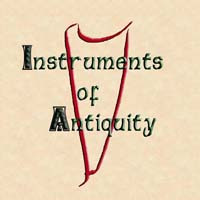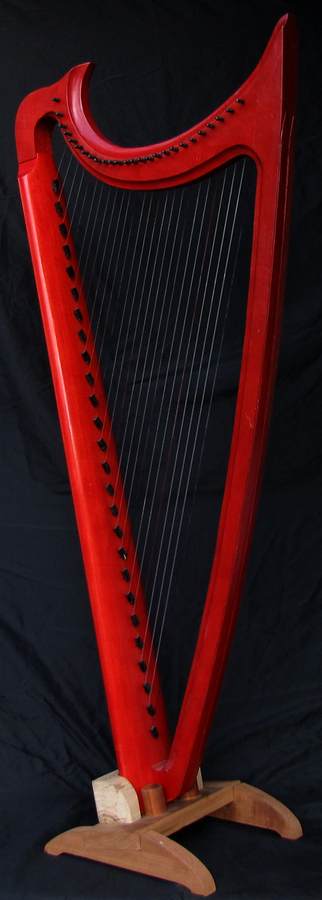
create for you?
(Links lead to detailed pages with larger photos and more information...)
Authentic:
Citole:
Cantigas style
Warwick style
Drums:
Bodhran
Gusli
Harps:
Bardic/Lap Harps:
Gut Strung
Celtic Wire Strung
Floor Harps:
Gothic
(more to come)
Kantele:
5 string
5 string Piccolo
9 string
Performance set
Lyres:
Trossingen
Sutton Hoo
Mosning Thorpe
Bergh Apton
Oberflacht
Cologne
Student Model
Bowed Lyres:
Crwth
Jouhikko
Psaltries:
Pig Nose
Cantigas style
Rebecs:
Soprano
Alto
Tenor
Bass
Zithers:
Fretted:
Epignette
Scheitholt
Fretless:
Myrna Hammered Dulcimer
Echoic:
Non-authentic,
but imitative of
the sound of the original instrument
Flutes
Whistles
Floor Harps
Click
Thumbnail Images to Enlarge
 The harp is a
multi-stringed instrument in which the strings emerge perpendicular to
the soundboard with no acoustic bridge to couple the vibrations to the
instrument. The earliest harps were little more than specialized
hunter's bows with a sound cavity on one end and a few strings instead
of one. These angle harps were common for thousands of years, but
were more limited due to the mechanics involved in supporting a number
of fully tensioned strings in an open structure.
The harp is a
multi-stringed instrument in which the strings emerge perpendicular to
the soundboard with no acoustic bridge to couple the vibrations to the
instrument. The earliest harps were little more than specialized
hunter's bows with a sound cavity on one end and a few strings instead
of one. These angle harps were common for thousands of years, but
were more limited due to the mechanics involved in supporting a number
of fully tensioned strings in an open structure.A revolution in harpmaking started to occur around the 7th century, in which the form of the harp began to evolve into the shape we recognize today. In the earliest days of this sea-change in harpbuilding, these instruments were smaller, made for portability and some have speculated as an extension of the range of the hand carried lyre. But a slower and yet very steady secondary development path appeared slightly later, with larger harps bearing more strings and an increased range and power being developed. The most majestic of the medieval large harps were the gothic harps, named not for their origin but their similarity in appearance to elements of gothic architecture.
Many of these harps, such as the 26 string model pictured here, employed a creative and unique method to capture more string energy and channel it back into the soundboard for more power, volume and projection. This was in the days before internal structures in larger harps allowed high tension wire strings and the volume and presence they allow. This method centered around modifying the pins that held the strings securely into the soundbox of the harp, adding a small 'flag' that could be positioned to just touch the string. The result was that as the string vibrated that energy was transferred back into the harp body and projected toward the listener. However, because these little flags were adjusted to barely touch the string at rest, when it was played they added a unique buzz or rasp to the tone of each string, reminiscent of a sitar. The buzz was thought to sound like the braying of a donkey, thus the name bray pins for the string pins or bray harp for a harp with them installed. The sound is not as unpleasant as the noise of a donkey, certainly, and it has an important place in the catalog of musical character of the middle ages, but for those times when it was not needed or desired the pins could simply be rotated out fo the way and the simple sound of the string, quieter but much cleaner, was all that remained.
We offer many choices in design, materials, number of strings, string spacing, instrument range, size, finish and other details, to help you become the owner of a one of a kind instrument reflecting how the magic of the harp reflects in you. And at a price that will surprise you.
For
more information or to place an order, contact:
Chris Nogy,
founder and craftsmancontact@instrumentsofantiquity.com
Phone: 479-283-6364
Please call between 9 AM and 7 PM U.S. Central Time (-6 GMT)
copyright (c) 2011